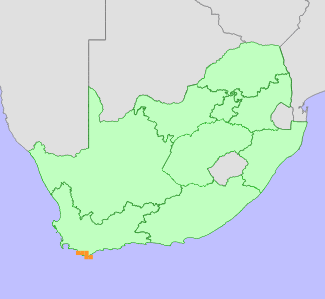|
Scientific Name | Serruria nervosa Meisn. |
Higher Classification | Dicotyledons |
Family | PROTEACEAE |
Synonyms | Serruria ventricosa E.Phillips & Hutch. |
Common Names | Fluted Spiderhead (e) |
National Status |
Status and Criteria | Near Threatened B1ab(iii)+2ab(iii) |
Assessment Date | 2020/04/15 |
Assessor(s) | A.G. Rebelo, H. Mtshali & L. von Staden |
Justification | Serruria nervosa has a limited distribution range, with an extent of occurrence (EOO) of 588 km², and an area of occupancy (AOO) of 116 km². It is declining in parts of its range due to ongoing habitat loss and degradation, but is still abundant, occurring at more than 10 locations. Therefore it nearly meets the thresholds for Vulnerable under criteria B. |
Distribution |
Endemism | South African endemic |
Provincial distribution | Western Cape |
Range | This species is endemic to a small area in the Western Cape Province, South Africa, where it occurs on coastal mountains from Kleinrivier to Agulhas. |
Habitat and Ecology |
Major system | Terrestrial |
Major habitats | Overberg Dune Strandveld, Overberg Sandstone Fynbos, Agulhas Limestone Fynbos, Agulhas Sand Fynbos |
Description | It grows in calcareous and acid sands on coastal flats, at an altitude of 20-250 m. Mature individuals are killed by fires, and only seeds survive. Seeds are released after ripening, and dispersed by ants to their underground nests, where they are protected from predation and fire. It is pollinated by insects. |
Threats |
| Serruria nervosa continues to decline on coastal flats due to habitat loss to coastal development, and urban expansion around Struisbaai. About 10% of its habitat is already irreversibly modified.
It has lost habitat in the past to agricultural expansion, mainly crops and protea plantations, in areas where it occurs in richer soils on the Agulhas Plain, but currently, the most severe threat in this area is competition from dense infestations of alien invasive plants that are outcompeting native species.
There is a low rate of habitat degradation by grazing livestock in some farms. |
Population |
This species has a limited distribution range, but is locally abundant in suitable habitat. There are 32 subpopulations known, the majority of which are large. The six smallest subpopulations, each with less than 100 plants, occur in Boesmansrivier and Hagelkraal. There is a continuing decline in the extent of suitable habitat outside protected areas due to habitat loss from agricultural expansion, and degradation of habitat by livestock and alien invasive plants.
|
Population trend | Decreasing |
Conservation |
| It is conserved at Salmonsdam, Heuningberg, Groot Hagelkraal, Rietfontein, and Renosterkop. |
Notes |
| This species was previously considered synonymous with S. bolusii, and is now treated separately. S. bolusii has multiple heads with adpressed hairs on the perianth compared to S. nervosa with mostly single heads and erect hairs on the perianth. |
Assessment History |
Taxon assessed |
Status and Criteria |
Citation/Red List version | | Serruria nervosa Meisn. | NT D2 | Raimondo et al. (2009) | |
Bibliography |
Goldblatt, P. and Manning, J.C. 2000. Cape Plants: A conspectus of the Cape Flora of South Africa. Strelitzia 9. National Botanical Institute, Cape Town.
Manning, J.C. and Goldblatt, P. 2012. Plants of the Greater Cape Floristic Region 1: The Core Cape Flora. Strelitzia 29. South African National Biodiversity Institute, Pretoria.
Raimondo, D., von Staden, L., Foden, W., Victor, J.E., Helme, N.A., Turner, R.C., Kamundi, D.A. and Manyama, P.A. 2009. Red List of South African Plants. Strelitzia 25. South African National Biodiversity Institute, Pretoria.
Rebelo, T. 2001. Sasol Proteas: A field guide to the proteas of southern Africa. (2nd ed.). Fernwood Press, Vlaeberg, Cape Town.
|
Citation |
| Rebelo, A.G., Mtshali, H. & von Staden, L. 2020. Serruria nervosa Meisn. National Assessment: Red List of South African Plants version . Accessed on 2025/04/14 |
 Comment on this assessment
Comment on this assessment

